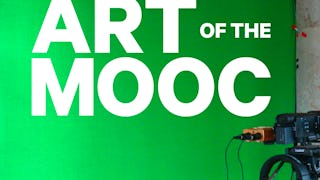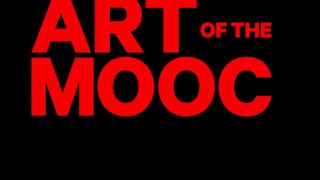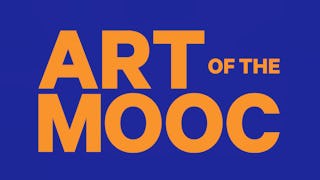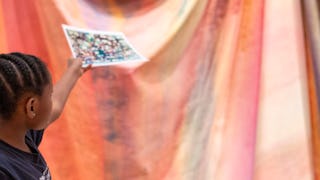Welcome to Art of the MOOC - Colors, Bodies, Power! In this course, you will gain a much more diverse and inclusive understanding of contemporary culture and global art history. Engaging the course's key ideas of colors, bodies and power for their own formal merit and the value of the artworks and artists represented, you will also learn from six experts in the field, learn how key artworks and artistic principles from areas as wide as color theory, performance studies, and cultural theory relate to larger social topics like indigeneity, race, gender, sexuality, and disabilities. Whether you are interested in art and culture for personal or professional reasons, this course will allow you to connect important aspects of your life and practice to some of the most current and relevant aspects of contemporary art and social theory. As one of four in a series, 'Colors, Bodies, Power' complements and enriches the materials covered in the other ART of the MOOC courses.


您将学到什么
Apply a wide range of practical and artistic principles as demonstrated by the many case studies and artworks discussed in the lectures
Gain a much more diverse and inclusive understanding of contemporary culture and global art history
Understand how race, gender, sexuality, and disabilities have been approached by key contemporary artists and artworks
Analyze even the most challenging contemporary cultural phenomena for your own personal or professional benefit
您将获得的技能
要了解的详细信息

添加到您的领英档案
4 项作业
了解顶级公司的员工如何掌握热门技能

积累特定领域的专业知识
- 向行业专家学习新概念
- 获得对主题或工具的基础理解
- 通过实践项目培养工作相关技能
- 获得可共享的职业证书

该课程共有4个模块
Based on the expertise of this module's co-instructors, our lectures connect key contemporary artists and artworks with the concepts of freedom, disability studies, race and indigeneity. Followed by a brief overview with ART of the MOOC creator Pedro Lasch, Colors (Introductory) presents scientific and optical color theories, diverse approaches to abstract color, as well as the history of skin tone as a way to organize society. Bodies (Introductory) focuses on how disability studies can help us rethink our bodies and society at large, also empowering and better understanding the struggle of disabled individuals and artists. Power (Introductory) brings together Indigenous and non-Indigenous artworks that address globally relevant political concepts like humor, sovereignty, matriarchy, and linguistic diversity.
涵盖的内容
5个视频6篇阅读材料1个作业
Based on the expertise of this module's co-instructors, our lectures connect key contemporary artists and artworks with the areas of Black Performance, Native culture, Middle Eastern art, and whiteness as a concept. Colors (Intermediate) celebrates the richness that Indigenous artists have brought to color, while also presenting Native art as a critical perspective to global and physical experience. Bodies (Intermediate) highlights the central role of artists of color for the areas of embodied knowledge and performance art. Power (Intermediate) introduces some of the key contributions of Muslim and Middle Eastern artists within global debates around gender, religion, and geopolitics. White Sight - Part 1 introduces analytical frameworks and case studies that help us escape local and global narratives rooted in both overt and covert forms of racism and white supremacy.
涵盖的内容
4个视频1个作业
Based on the expertise of this module's co-instructors, our lectures connect key contemporary artists and artworks with ideas of new media, diaspora, landscape and natural history. Colors (Advanced) focuses on the ways in which particular landscapes and cultural contexts impact our experience and understanding of color. Bodies (Advanced) explores the relation between avatars, robots, and other such forms with the history of gendered and racialized people. Power (Advanced) continues with a set of reflections on the social and political forms that have characterized black emancipation. White Sight - Part 2 closes the module with case studies that unpack the relationship between white colonialism, monuments, and prevalent understandings of natural history and its museums.
涵盖的内容
4个视频1个作业
Based on the expertise of this week's co-instructors, our lectures connect key contemporary artists and artworks with the concepts of diaspora, sexuality, border crossing, and collective liberation. Colors (Conclusion) focuses on ways in which black artists worldwide have redefined color, both as an artistic element and a social phenomenon. Bodies (Conclusion) presents select examples of contemporary Native performance and installation art that help us better understand the relation between our bodies and the environment, as well as the concepts of the natural and the synthetic. Power (Conclusion) brings many of our previous discussions of the body and power in dialogue with each other, focusing on artworks that address technology, screens, labor, sex and sexuality. White Sight (Part 3) concludes our course with an invitation to practice different forms of visual activism, providing examples of recent case studies from feminism, racial justice movements, and contemporary art that may inspire collective liberation.
涵盖的内容
4个视频1篇阅读材料1个作业
获得职业证书
将此证书添加到您的 LinkedIn 个人资料、简历或履历中。在社交媒体和绩效考核中分享。
从 Music and Art 浏览更多内容
 状态:免费试用
状态:免费试用Duke University
 状态:免费试用
状态:免费试用Duke University
 状态:免费试用
状态:免费试用Duke University
 状态:免费试用
状态:免费试用The Museum of Modern Art
人们为什么选择 Coursera 来帮助自己实现职业发展




常见问题
To access the course materials, assignments and to earn a Certificate, you will need to purchase the Certificate experience when you enroll in a course. You can try a Free Trial instead, or apply for Financial Aid. The course may offer 'Full Course, No Certificate' instead. This option lets you see all course materials, submit required assessments, and get a final grade. This also means that you will not be able to purchase a Certificate experience.
When you enroll in the course, you get access to all of the courses in the Specialization, and you earn a certificate when you complete the work. Your electronic Certificate will be added to your Accomplishments page - from there, you can print your Certificate or add it to your LinkedIn profile.
Yes. In select learning programs, you can apply for financial aid or a scholarship if you can’t afford the enrollment fee. If fin aid or scholarship is available for your learning program selection, you’ll find a link to apply on the description page.
更多问题
提供助学金,







 中
中

